# 14.4 使用ThreadSaniiser向CDash报告数据争用
**NOTE**:*此示例代码可以在 https://github.com/dev-cafe/cmake-cookbook/tree/v1.0/chapter-14/recipe-03 中找到,其中包含一个C++示例。该示例在CMake 3.5版(或更高版本)中是有效的,并且已经在GNU/Linux、macOS和Windows上进行过测试。*
在这个示例中,我们将重用前一个示例中的方法,但是使用ThreadSanitizer或TSan,结合CTest和CDash,来检查数据竞争,并将它们报告给CDash。ThreadSanitizer的文档可以在网上找到,https://github.com/google/sanitizers/wiki/ThreadSanitizerCppManual
## 准备工作
这个示例中,我们将使用以下示例代码(`example.cpp`):
```c++
#include <chrono>
#include <iostream>
#include <thread>
static const int num_threads = 16;
void increase(int i, int &s) {
std::this_thread::sleep_for(std::chrono::seconds(1));
std::cout << "thread " << i << " increases " << s++ << std::endl;
}
int main() {
std::thread t[num_threads];
int s = 0;
// start threads
for (auto i = 0; i < num_threads; i++) {
t[i] = std::thread(increase, i, std::ref(s));
}
// join threads with main thread
for (auto i = 0; i < num_threads; i++) {
t[i].join();
}
std::cout << "final s: " << s << std::endl;
return 0;
}
```
这个示例代码中,我们启动16个线程,每个线程都调用`increase`函数。`increase`函数休眠1s,然后打印并递增一个整数`s`。我们预计此示例代码将显示数据竞争,因为所有线程读取和修改相同的地址,而不需要任何显式同步或协调。换句话说,我们期望在代码末尾打印的最终`s`,每次的结果都不同。代码有bug,我们将尝试在ThreadSanitizer的帮助下识别数据竞争。如果不运行ThreadSanitizer,我们可能不会看到代码有任何问题:
```shell
$ ./example
thread thread 0 increases 01 increases 1
thread 9 increases 2
thread 4 increases 3
thread 10 increases 4
thread 2 increases 5
thread 3 increases 6
thread 13 increases 7
thread thread 7 increases 8
thread 14 increases 9
thread 8 increases 10
thread 12 increases 11
thread 15 increases 12
thread 11 increases 13
5 increases 14
thread 6 increases 15
final s: 16
```
## 具体实施
1. 文件`CMakeLists.txt`首先定义一个受支持的最低版本、项目名称、受支持的语言。在本例中,定义了C++11标准项目:
```cmake
cmake_minimum_required(VERSION 3.5 FATAL_ERROR)
project(recipe-04 LANGUAGES CXX)
set(CMAKE_CXX_STANDARD 11)
set(CMAKE_CXX_EXTENSIONS OFF)
set(CMAKE_CXX_STANDARD_REQUIRED ON)
```
2. 接下来,找到线程库,定义可执行文件,并将其链接到线程库:
```cmake
find_package(Threads REQUIRED)
add_executable(example example.cpp)
target_link_libraries(example
PUBLIC
Threads::Threads
)
```
3. 然后,提供编译选项和代码,并链接到ThreadSanitizer:
```cmake
option(ENABLE_TSAN "Enable ThreadSanitizer" OFF)
if(ENABLE_TSAN)
if(CMAKE_CXX_COMPILER_ID MATCHES GNU)
message(STATUS "ThreadSanitizer enabled")
target_compile_options(example
PUBLIC
-g -O1 -fsanitize=thread -fno-omit-frame-pointer -fPIC
)
target_link_libraries(example
PUBLIC
tsan
)
else()
message(WARNING "ThreadSanitizer not supported for this compiler")
endif()
endif()
```
4. 最后,编译测试用例:
```cmake
enable_testing()
# allow to report to a cdash dashboard
include(CTest)
add_test(
NAME
example
COMMAND
$<TARGET_FILE:example>
)
```
5. ` CTestConfig.cmake`没有变化:
```cmake
set(CTEST_DROP_METHOD "http")
set(CTEST_DROP_SITE "my.cdash.org")
set(CTEST_DROP_LOCATION "/submit.php?project=cmake-cookbook")
set(CTEST_DROP_SITE_CDASH TRUE)
```
6. `dashboard.cmake `需要为TSan进行简单修改:
```cmake
set(CTEST_PROJECT_NAME "example")
cmake_host_system_information(RESULT _site QUERY HOSTNAME)
set(CTEST_SITE ${_site})
set(CTEST_BUILD_NAME "${CMAKE_SYSTEM_NAME}-${CMAKE_HOST_SYSTEM_PROCESSOR}")
set(CTEST_SOURCE_DIRECTORY "${CTEST_SCRIPT_DIRECTORY}")
set(CTEST_BINARY_DIRECTORY "${CTEST_SCRIPT_DIRECTORY}/build")
include(ProcessorCount)
ProcessorCount(N)
if(NOT N EQUAL 0)
set(CTEST_BUILD_FLAGS -j${N})
set(ctest_test_args ${ctest_test_args} PARALLEL_LEVEL ${N})
endif()
ctest_start(Experimental)
ctest_configure(
OPTIONS
-DENABLE_TSAN:BOOL=ON
)
ctest_build()
ctest_test()
set(CTEST_MEMORYCHECK_TYPE "ThreadSanitizer")
ctest_memcheck()
ctest_submit()
```
7. 让我们以这个例子为例。通过`CTEST_CMAKE_GENERATOR`选项来设置生成器:
```shell
$ ctest -S dashboard.cmake -D CTEST_CMAKE_GENERATOR="Unix Makefiles"
Each . represents 1024 bytes of output
. Size of output: 0K
Each symbol represents 1024 bytes of output.
'!' represents an error and '*' a warning.
. Size of output: 0K
```
8. 在面板上,我们将看到以下内容:

9. 我们可以看到更详细的动态分析:

## 工作原理
该示例`CMakeLists.txt`的核心部分:
```cmake
option(ENABLE_TSAN "Enable ThreadSanitizer" OFF)
if(ENABLE_TSAN)
if(CMAKE_CXX_COMPILER_ID MATCHES GNU)
message(STATUS "ThreadSanitizer enabled")
target_compile_options(example
PUBLIC
-g -O1 -fsanitize=thread -fno-omit-frame-pointer -fPIC
)
target_link_libraries(example
PUBLIC
tsan
)
else()
message(WARNING "ThreadSanitizer not supported for this compiler")
endif()
endif()
```
`dashboard.cmake`也需要更新:
```cmake
# ...
ctest_start(Experimental)
ctest_configure(
OPTIONS
-DENABLE_TSAN:BOOL=ON
)
ctest_build()
ctest_test()
set(CTEST_MEMORYCHECK_TYPE "ThreadSanitizer")
ctest_memcheck()
ctest_submit()
```
和上一个示例一样,我们也可以在本地查看ThreadSanitizer的输出:
```shell
$ mkdir -p build
$ cd build
$ cmake -DENABLE_TSAN=ON ..
$ cmake --build .
$ cmake --build . --target test
Start 1: example
1/1 Test #1: example ..........................***Failed 1.07 sec
0% tests passed, 1 tests failed out of 1
$ ./build/example
thread 0 increases 0
==================
WARNING: ThreadSanitizer: data race (pid=24563)
... lots of output ...
SUMMARY: ThreadSanitizer: data race /home/user/cmake-recipes/chapter-14/recipe-04/cxx-example/example
```
## 更多信息
对使用OpenMP的应用TSan是很常见的,但是请注意,在某些情况下,OpenMP会在TSan下生成误检的结果。对于Clang编译器,一个解决方案是用`-DLIBOMP_TSAN_SUPPORT=TRUE`重新编译编译器本身及其`libomp`。通常,以合理的方式使用TSan可能需要重新编译整个工具堆栈,以避免误报。在使用pybind11的C++项目的情况,我们可能需要重新编译Python,并启用TSan来获得有意义的东西。或者,Python绑定可以通过使用TSan抑制而被排除在外,如 https://github.com/google/sanitizers/wiki/threadsanitizersuppression 。例如:如果一个动态库同时被一个经过TSan的二进制文件和一个Python插件调用,那么这种情况可能是不可能使用TSan。
下面的博客文章讨论了如何添加对动态分析工具的支持:https://blog.kitware.com/ctest-cdash-add-support-for-new-dynamic-analysis-tools/
- Introduction
- 前言
- 第0章 配置环境
- 0.1 获取代码
- 0.2 Docker镜像
- 0.3 安装必要的软件
- 0.4 测试环境
- 0.5 上报问题并提出改进建议
- 第1章 从可执行文件到库
- 1.1 将单个源文件编译为可执行文件
- 1.2 切换生成器
- 1.3 构建和链接静态库和动态库
- 1.4 用条件句控制编译
- 1.5 向用户显示选项
- 1.6 指定编译器
- 1.7 切换构建类型
- 1.8 设置编译器选项
- 1.9 为语言设定标准
- 1.10 使用控制流
- 第2章 检测环境
- 2.1 检测操作系统
- 2.2 处理与平台相关的源代码
- 2.3 处理与编译器相关的源代码
- 2.4 检测处理器体系结构
- 2.5 检测处理器指令集
- 2.6 为Eigen库使能向量化
- 第3章 检测外部库和程序
- 3.1 检测Python解释器
- 3.2 检测Python库
- 3.3 检测Python模块和包
- 3.4 检测BLAS和LAPACK数学库
- 3.5 检测OpenMP的并行环境
- 3.6 检测MPI的并行环境
- 3.7 检测Eigen库
- 3.8 检测Boost库
- 3.9 检测外部库:Ⅰ. 使用pkg-config
- 3.10 检测外部库:Ⅱ. 自定义find模块
- 第4章 创建和运行测试
- 4.1 创建一个简单的单元测试
- 4.2 使用Catch2库进行单元测试
- 4.3 使用Google Test库进行单元测试
- 4.4 使用Boost Test进行单元测试
- 4.5 使用动态分析来检测内存缺陷
- 4.6 预期测试失败
- 4.7 使用超时测试运行时间过长的测试
- 4.8 并行测试
- 4.9 运行测试子集
- 4.10 使用测试固件
- 第5章 配置时和构建时的操作
- 5.1 使用平台无关的文件操作
- 5.2 配置时运行自定义命令
- 5.3 构建时运行自定义命令:Ⅰ. 使用add_custom_command
- 5.4 构建时运行自定义命令:Ⅱ. 使用add_custom_target
- 5.5 构建时为特定目标运行自定义命令
- 5.6 探究编译和链接命令
- 5.7 探究编译器标志命令
- 5.8 探究可执行命令
- 5.9 使用生成器表达式微调配置和编译
- 第6章 生成源码
- 6.1 配置时生成源码
- 6.2 使用Python在配置时生成源码
- 6.3 构建时使用Python生成源码
- 6.4 记录项目版本信息以便报告
- 6.5 从文件中记录项目版本
- 6.6 配置时记录Git Hash值
- 6.7 构建时记录Git Hash值
- 第7章 构建项目
- 7.1 使用函数和宏重用代码
- 7.2 将CMake源代码分成模块
- 7.3 编写函数来测试和设置编译器标志
- 7.4 用指定参数定义函数或宏
- 7.5 重新定义函数和宏
- 7.6 使用废弃函数、宏和变量
- 7.7 add_subdirectory的限定范围
- 7.8 使用target_sources避免全局变量
- 7.9 组织Fortran项目
- 第8章 超级构建模式
- 8.1 使用超级构建模式
- 8.2 使用超级构建管理依赖项:Ⅰ.Boost库
- 8.3 使用超级构建管理依赖项:Ⅱ.FFTW库
- 8.4 使用超级构建管理依赖项:Ⅲ.Google Test框架
- 8.5 使用超级构建支持项目
- 第9章 语言混合项目
- 9.1 使用C/C++库构建Fortran项目
- 9.2 使用Fortran库构建C/C++项目
- 9.3 使用Cython构建C++和Python项目
- 9.4 使用Boost.Python构建C++和Python项目
- 9.5 使用pybind11构建C++和Python项目
- 9.6 使用Python CFFI混合C,C++,Fortran和Python
- 第10章 编写安装程序
- 10.1 安装项目
- 10.2 生成输出头文件
- 10.3 输出目标
- 10.4 安装超级构建
- 第11章 打包项目
- 11.1 生成源代码和二进制包
- 11.2 通过PyPI发布使用CMake/pybind11构建的C++/Python项目
- 11.3 通过PyPI发布使用CMake/CFFI构建C/Fortran/Python项目
- 11.4 以Conda包的形式发布一个简单的项目
- 11.5 将Conda包作为依赖项发布给项目
- 第12章 构建文档
- 12.1 使用Doxygen构建文档
- 12.2 使用Sphinx构建文档
- 12.3 结合Doxygen和Sphinx
- 第13章 选择生成器和交叉编译
- 13.1 使用CMake构建Visual Studio 2017项目
- 13.2 交叉编译hello world示例
- 13.3 使用OpenMP并行化交叉编译Windows二进制文件
- 第14章 测试面板
- 14.1 将测试部署到CDash
- 14.2 CDash显示测试覆盖率
- 14.3 使用AddressSanifier向CDash报告内存缺陷
- 14.4 使用ThreadSaniiser向CDash报告数据争用
- 第15章 使用CMake构建已有项目
- 15.1 如何开始迁移项目
- 15.2 生成文件并编写平台检查
- 15.3 检测所需的链接和依赖关系
- 15.4 复制编译标志
- 15.5 移植测试
- 15.6 移植安装目标
- 15.7 进一步迁移的措施
- 15.8 项目转换为CMake的常见问题
- 第16章 可能感兴趣的书
- 16.1 留下评论——让其他读者知道你的想法
